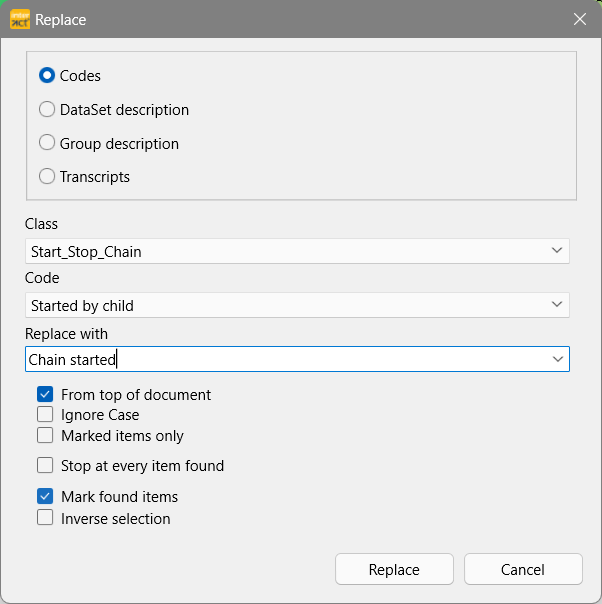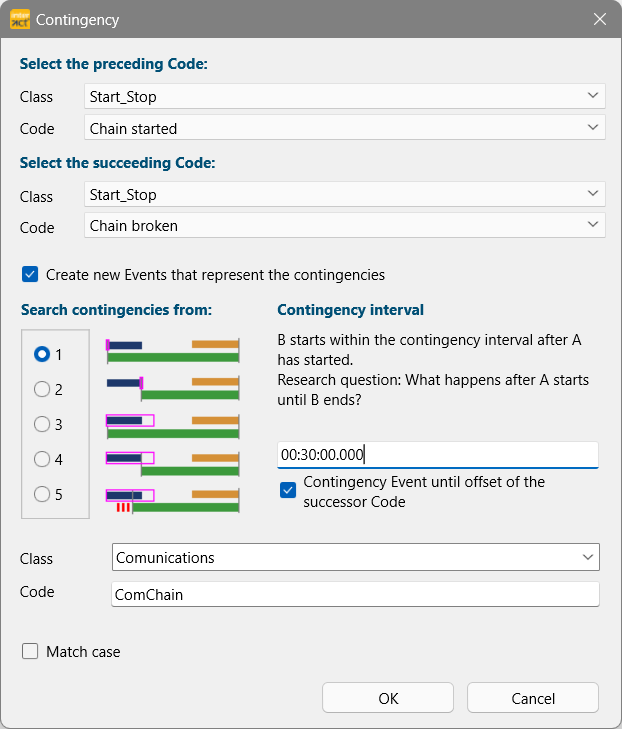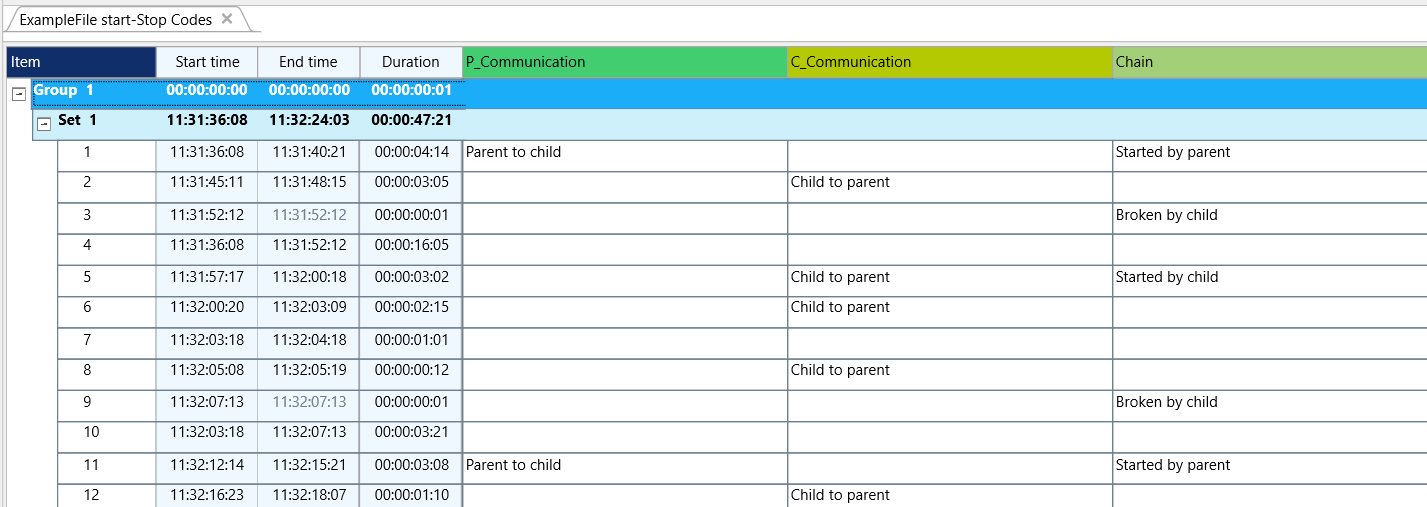Presume you want to extract the duration for chains of communication. For this example, a rather special Coding System was developed, but it works for all kinds of situations.
All we need are specified 'Start' and 'End' Codes to identify the period of interest.
If your system does not include dedicated start and End Codes, we can copy the Codes that imply the various starting point to an additional Class and rename them to create generic 'Start' and 'Stop' Codes.
In a Nutshell: You can extract or copy available information from one Class into a new Class, using the Move / combine functionality of INTERACT.
Than, you can change those duplicate Codes into more generic Codes, using the Replace functionality to rename the moved and/or copied codes.
Create Generic Start-Stop Codes
Presume you have logged Events using these Codes: 'Parent to child' / 'Child to parent' / 'Child started chain' / 'Parent started chain' / 'Chain broke by child' / 'Chain broken by parent'.
And all Codes have been collected in two Classes e.g. 'C_Communication' and 'P_Communication':
If your data file looks like in this image, you can still extract the required information by adding the generic start-stop Code with a few mouse clicks.
First, you need to duplicate the Codes for starting an ending a chain like this:
▪Right-Click on the Class column 'Chain'.
▪Select Duplicate Class from the Context menu.
▪Double-click the new column header and rename the just duplicated column into something like 'Start_Stop_Chain'.
The result should now look something like this:
Now we need to create the generic 'Start of chain' and 'End of chain' codes. This is done by replacing the original Codes like this:
▪Click Edit – Find & Replace - Replace ![]() in the menu.
in the menu.
Enter the data for the first 'Start' Code like this:

▪Perform this action also for the Code 'Child started chain' replace with.... 'Chain started'.
Make sure you select the correct Class!
▪Repeat this action also for the 'End' codes (e.g. replace 'Chain broken by child' and 'Chain broken by parent' both with 'Chain broken'), until you have only two Codes (e.g. 'Chain started' and 'Chain broken') in the Class columns 'Start_Stop_chain'.
Now you can use the Contingency Analysis to create your 'Communicytion Chain Events':
If you log Events as described in Chains of Communication Setup, the results are stored like this:
| TIP: | If you did not log your events with so many 'double' Codes as described in this example, you can maybe use the powerful Move / Combine Codes functionality in combination with the Replace... action to create additional Codes in separate Classes, that will allow you to perform a proper search (also see the example in Extend your coded data). |
Create Communication Chain Events
Based on the information logged like this, INTERACT can create the communication chain Events for you:
▪Click Analysis - Time sequence - Contingency ▪Select the Class 'Start_Stop' and the Code 'Chain started' as the preceding class. ▪Select the Class 'Start_Stop' and the Code 'Chain broken' as the succeeding class. ▪Set the Contingency interval to match at least your session duration. ▪Make sure the analysis is based on the Event start time. ▪Select the option Create new Events which represent the contingencies. ▪Also select the option Contingency Event until offset of the successor Code, to include the duration of the Event that broke the communication. ▪Enter a name for the Class that should hold the new Events, for example 'Communications' ▪Enter an expression for the Codes that identify the new Events, for example 'ComChain'. |
 |
▪Click OK to start the process.
INTERACT now looks for the first occurrence of the 'Chain started' Code and, after finding one, it remembers the corresponding start time and starts searching for the next in line 'Chain broken' Event.
If a new 'Chain started' Event is found instead, the previously remembered start time is replace by the new start time.
Once a 'Chain broken' is found, a new Event is created, using the memorized start time of the last 'Start' Code Event and the offset of the 'End'-Code for time information.
After this, INTERACT starts looking for the next 'Chain started' Event, etc.
If you do have a document containing usable Codes, simply follow the instructions. If not, try to create those Codes using the Move & Combine codes routine or insert additional Codes manually using the Refine Events method.


